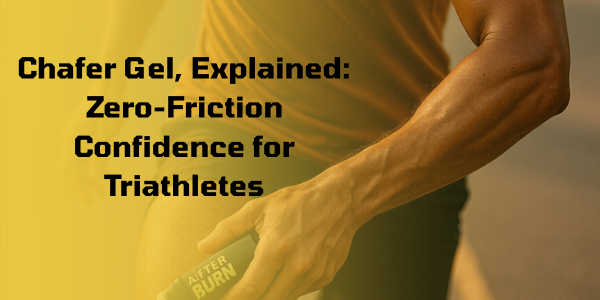4-Week Sprint Triathlon Training Program
Let’s turn four weeks into a confident finish. You’ll get structured swim–bike–run sessions, brick workouts, race-week taper, fueling, and transition checklists. Clean, simple, and ruthlessly effective.
Coach’s Answer: Can you train for a sprint triathlon in 4 weeks?
Yes—if you can swim 100–200 m continuously, bike 20–30 minutes, and jog 15 minutes today. Follow four blocks: Foundation → Endurance + Controlled Speed → Specificity → Taper. Include 1–2 bricks per week and rehearse transitions.
Is a 4-Week Sprint Plan Right for You?
- Swim 100–200 m without stopping
- Bike 20–30 minutes steady
- Jog 15 minutes conversational
That’s your green light. If you’re returning from injury, progress conservatively and swap any sharp efforts for easy aerobic time. Need a gear sanity check? Our essential triathlon gear guide lays out a lean kit that just works.
Clothing questions pop up too. Unsure about layers? See this pragmatic breakdown on shorts vs tights for running.
Time Budget
Expect 5–7 hours per week with two tracks:
- Finish Calm – steady zones, technique focus
- Chase a PR – slightly stronger intervals, tighter bricks
Shoulders bug you when you run? Fix posture and arm swing with our quick primer: why shoulders hurt when running.
How This Program Works (Streetlight Coach Method)
Intensity Guide (Conversational SEO: “RPE zones for sprint triathlon”)
- Easy / Aerobic: RPE 3–4 (you can chat)
- Steady: RPE 5–6 (focused, but controlled)
- Race-Pace Feel: RPE 7–8 (firm, sustainable)
- Strides / Pops: 15–30s fast with full recovery
Swimming sighting, bike cadence ≥90 rpm, and a relaxed mid-foot run stride are our keystones. Odd mouth sensations during hard runs? Here’s a science-lite explainer on why teeth can ache when running.
Key Terms
Brick: bike → run back-to-back. Negative Split: second half faster. Micro-transitions: actions you can perform while moving (e.g., goggles off while jogging to rack). For a fast bag setup, read the transition bag guide.
Your 4-Week Sprint Triathlon Training Program
Weekly Grid (Finish Calm)
| Week | Swim | Bike | Run | Brick | Strength/Mobility | Notes |
|---|---|---|---|---|---|---|
| 1 — Technique | 8×50 drills (catch-up, scull, sight 6–8); 800–1,000 m total | 45′ steady @ 90+ rpm | 25′ easy + 4×20″ strides | 30′ bike steady → 10′ easy jog | 20′ hips/core/ankles | Wetsuit on/off practice; sighting in shallow water |
| 2 — Endurance + Pops | 3×(200 steady + 4×50 build) | 2×10′ strong-steady (RPE 6–7) / 5′ easy | 30′: easy → steady last 10′ | 40′ bike steady → 15′ steady run | 20′ single-leg + calves | Dew point >65°F? Shorten intervals 10–15% |
| 3 — Specificity | 1,000 m continuous + 4×25 fast | 3×8′ target race effort | 40′: 10′ easy → 20′ steady → 5′ race feel | 50′ bike steady → 20′ run (last 5′ strong) | 20′ mobility + glutes | Course recon; mounts/dismounts |
| 4 — Taper | 600–800 m with 6×50 race feel | 30–40′ with 4×60″ race effort | 20–25′ with 4×20″ strides | Optional 20′ bike → 8′ jog mid-week | Light band work | Practice race-morning timeline |
Weekly Grid (Chase a PR)
| Week | Swim | Bike | Run | Brick | Strength/Mobility | Notes |
|---|---|---|---|---|---|---|
| 1 — Technique+ | 6×75 drill-into-swim + 4×25 fast (1,100 m) | 50′ steady; 3×4′ cadence ≥95 rpm | 30′ easy + 6×20″ strides | 35′ bike steady → 12′ jog | 25′ hips/core/ankles | Practice T1 layout; elastic laces |
| 2 — Sweet Spot | 4×250 steady + 6×50 build | 3×8′ RPE 7 / 4′ easy | 35′: 10′ easy → 20′ steady → 5′ race feel | 45′ bike steady → 18′ run (last 4′ strong) | Single-leg RDLs + calves | Open-water entries/exits + drafting |
| 3 — Race Specific | 1,200 m continuous with buoy turns + 6×25 fast | 2×12′ race effort + 10′ steady | 42′: 12′ easy → 20′ steady → 6′ race | 60′ bike @ steady → 22′ run negative split | Glutes + mobility | Mount/dismount line rehearsal |
| 4 — Taper Sharpen | 800–1,000 m: 8×50 race feel | 35′ with 5×60″ @ race effort | 22′ with 5×20″ strides | Optional 15′ spin → 6′ jog | Light band work | Race-pace cadence check |
Fueling, Hydration & Recovery (Field-Tested, Zero Fluff)
Before
Carb-forward dinner; familiar breakfast 2–3 h pre-start. If it’s steamy, sip electrolytes earlier. Build your setup with our curated hydration and electrolyte selections.
During
Typical sprint: drink to thirst; consider 20–40 g carbs on the bike if you’ll race >60′ or in heat. Practice in weeks 2–3.
After
20–30 g protein + carbs within 60 minutes; legs up; short walk later. If friction reared its head, study “what chafe looks like” so you can stop it earlier next time: visual guide to chafing.
Skin Protection = Time Insurance
Friction costs seconds every stride. For a deeper dive into formulations and use-cases, compare anti-chafe running cream guides and the anti-chafe gel guide. Tri-specific? Start here: chafe gel explained for triathletes.
Transitions = Free Speed
Micro-transitions—those small, on-the-move actions—save more time than an extra interval. Rehearse T1 and T2 like they’re events.
T1: Swim → Bike
- Goggles and cap off while jogging to rack
- Helmet on first; shoes strategy pre-decided (clipped in vs on feet)
- Quick swipe of anti-chafe for underarms/thighs if wetsuit rubbed
Use a packing framework from the transition bag checklist.
T2: Bike → Run
- Feet out before dismount line, jog the bike by the saddle
- Slip on shoes (elastic laces), race belt, cap
- Re-apply anti-chafe if humid or you felt hotspots building
Want a lean, pro-style kit? Study the triathlon bag guide.
Gear mindset for race-day calm is half the battle. This blueprint nails it: gear & mindset for 2025 racers.
Indoor Alternatives (No Weather Excuses)
Pool → Drills
Swap open water with sighting drill sets and buoy turns at lane rope. If you crave deep technique content, see the science of stick-based skin protection—it applies to swim rub points too.
Trainer & Treadmill
Use ERG for sweet-spot blocks; treadmill strides at the end of easy runs. If you’re navigating niggles, scan our pro tactics for staying race-ready with a minor setback: can you run with a broken toe?
Packing Checklists & Skin Protection (Simple Wins Races)
Where & When to Apply Anti-Chafe
- Pre-swim: inner thighs, underarms, chest line, neck if wetsuit
- T2: re-apply for humid races and longer run legs
Browse formulations and use-cases in our anti-chafing collection, then take a 90-second crash course: crush friction guide.
Curious how balms stack up? This comparison is for you: science-backed anti-chafe balm.
Race-Morning Timeline (Do This, Then This)
T-24 Hours
- Packet pickup, rack height set, mount/dismount lines scouted
- Check forecast, finalize gear & labeling
T-90 to T-60 Minutes
- Arrive, rack bike, lay out T1/T2 exactly as practiced
- Light jog + dynamic mobility; visualize first 3 minutes of swim
T-45 to T-20 Minutes
- Wetsuit on (if legal), sip fluid, 3–4 short swim pickups
- Last restroom window
T-10 Minutes
- Breathing drill: 4× deep nasal in / slow mouth out
- Find feet to draft; rehearse the first buoy line in your head
Learn to pack like a minimalist pro with our transition bag blueprint.
Further Reading & Resources
- Chafe-proof strategies: elite anti-chafe running guide
- Coach-vetted picks: best running anti-chafe 2025
- Science-forward deep dive: anti-chafe gel science
- Newsletter for training intel: The Three-Stride Tribune
- Mindset + essentials: expert triathlon essentials
- Transition bag checklist: pack like a pro in 2025
- Be part of the movement: becoming a Streetlight Athlete
- Brand ethos & HQ: Streetlight Athletics home
One-Click Reads to Level Up
- Comprehensive friction playbook: anti-chafe stick for running—Streetlight advantage
- Transition bag brains: pack faster, race smarter
FAQs: 4-Week Sprint Triathlon Training Program
Can a true beginner finish on this plan?
Yes—if you pass the self-check listed above. Otherwise take 2–3 weeks of base building first, then start this 4-week plan. Need a quick refresher on friction management? Scan the best anti-chafing stick for runners & triathletes page.
How many hours per week do I need?
Most athletes thrive at 5–7 hours. Busy week? Keep bricks and drop a filler run. Curious about balms vs creams? Read our anti-chafe cream guide.
What if I can’t swim in open water?
Use pool sighting reps every 6–8 strokes and practice buoy turns at lane rope. If shoulder niggles hit mid-cycle, triage with this explainer: friction-fighting in 90 seconds.
Do I need a tri bike?
No. A well-maintained road bike with clip-on aerobars is plenty. Keep focus on cadence and brick frequency. For run kit questions, compare fabrics in our shorts vs tights analysis.



